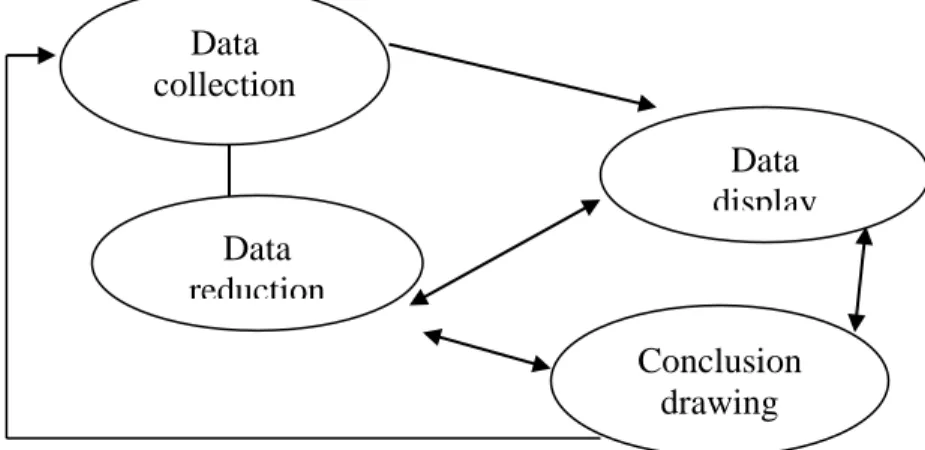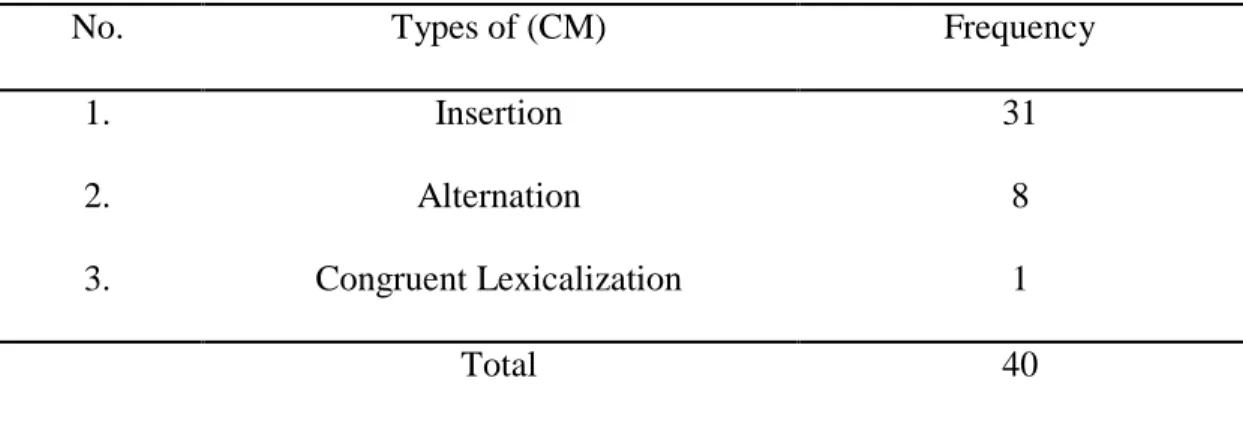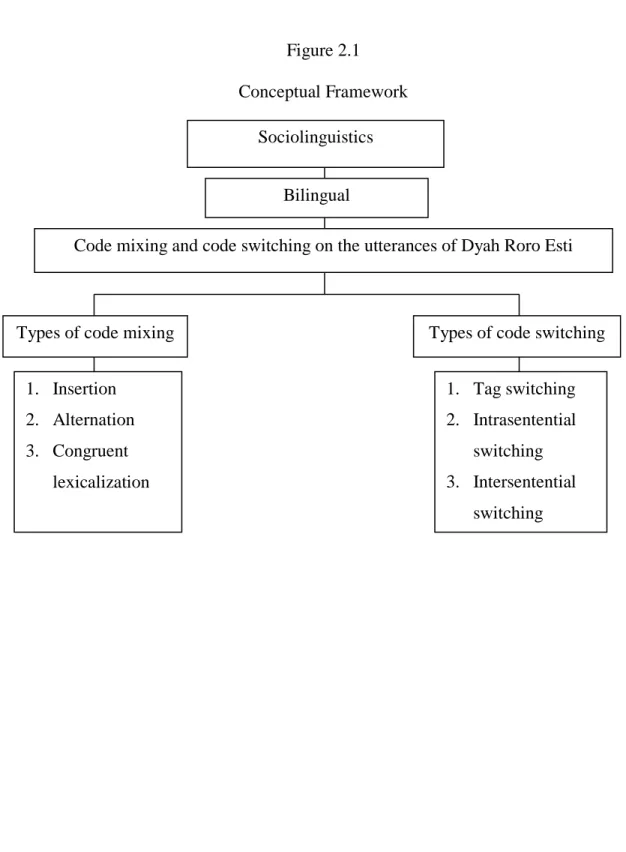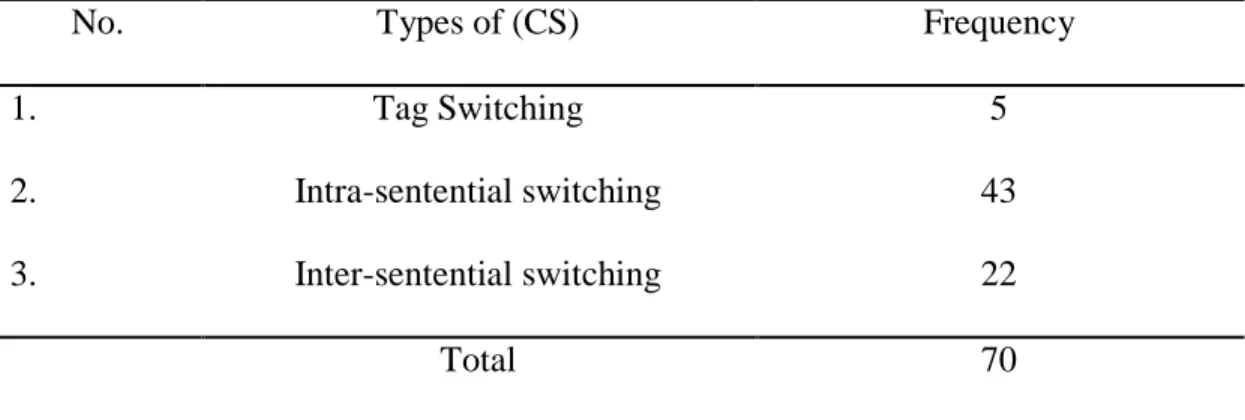The title of the research was the discovery of types of code mixing and switching. This research focuses on the analysis of Dyah Roro Esti's utterances in the Podcast where the channel is "Millennial Power" which contained code-mixing and code-switching in audio as research data. The result of this research revealed that there are three types of code mixing and code switching.
Code switching included tag switching where 5 data occurred, intra-sentential circuit 43 data, and inter-sentential circuit 22 data. It was expected that this research would help anyone who wants to know more about bilingualism and code mixing and code switching. Alhamdulillahirabbil „alamin, praise be to Allah, who by His kindness allows the researcher to design this mini thesis entitled “An Analysis of Code Mixing and Code Switching on Millennial Power Channel Podcast”.
Hum, as the researcher's supervisor who has already given valuable time to give comments and suggestions during the design of this mini-thesis.
- The Background of the Study
- The Identification of the Problem
- The Scope and Limitation
- The Formulation of the Study
- The Objective of the Study
- The Significant of the Study
This study will analyze the types of code mixing and code switching by Dyah Roro Esti. This research was focused on analyzing type of code mixing and code switching used by Dyah Roro Esti on Podcast. What were the types of code mixing and code switching used by Dyah Roro Esti in her talk on Millennial Power Channel Podcast.
What types of code mixing and switching were often used by Dyah Roro Esti. To discover the types of code-mixing and code-switching used by Dyah Roro Esti in her talk on the Millennial Power Channel Podcast. To discover the types of code mixing and switching that were frequently used by Dyah Roro Esti.
This research aims to provide more knowledge about sociolinguistics about bilingualism, especially the types of code mixing and code switching.
Theoretical Framework
- Sociolinguistics
- Bilingualism
- Code Mixing
- Code Switching
- Podcast
According to Kachru in Suwito (1985, p. 89), code mixing is the use of two or more languages by inserting one language element into another language element in one utterance. When two or more languages exist in a community, speakers often switch from one language to another, this phenomenon is known as code-switching. Tag switching, where tags and certain fixed phrases in one language are inserted into an utterance in another language.
Tag switching, where tags in one language are inserted into a sentence in another language. It means that speakers switch from one language to another within the same sentence. Intersentential switching, where there is a change of language at the sentence level, where each clause or sentence is in one language or the other.
Intersentential code-switching occurs when, after he/she has finished a sentence in one language, the speaker switches to another language in the next sentence, or occurs at sentence levels where each sentence or phrase is in one language or the other as illustrated in the following examples demonstrating code-switching between English and Indonesian.
Related Study
These two studies related to the types of code mixing and code switching and the reasons why code mixing and code switching are used. Both studies focused on only one code, while the researcher focused on both code mixing and code switching.
Conceptual Framework
- Research Design
- Source of Data
- Techniques for collecting Data
- Techniques for Analysis the Data
In this technique, the author was not involved directly in the dialogues on the Podcast. The data used in this research was secondary data which consisted of code mixing and code switching on the utterances of Dyah Roro Esti on the Millennial Power Channel Podcast. In data reduction, the researcher performs the process of selecting, focusing, simplifying, and abstracting from all types of information that support the research data obtained.
In this step, the researcher makes a brief note of the data by Dyah Roro Esti by coding the data into the types themselves. Data display is a collection of information that gives researcher the possibility to draw conclusions and take action. In this step, the data is presented by Dyah Roro Esti in narrative form that separated the data based on the type of classification of the utterances used by Dyah Roro Esti.
The researcher must try to find meaning based on data that has been fully and deeply explored.

Data
Data Analysis
The sentence above counts as a code mix because Esti mixes a single phrase "very different" in pronunciation into a long Indonesian sentence. The above sentence counts as a code mix because Esti mixes a single phrase "waste sector" into the pronunciation of a long Indonesian sentence. The sentence above counts as code-mixing because Esti mixes a single hybrid menfulfill into the sentence in a long Indonesian sentence.
The utterance above is counted as code mixing because Esti mixes a single phrase "energy demand" into the utterance in one sentence long of Indonesian. The utterance above is counted as code-mixing because Esti mixes a single word "successful" in the utterance in one sentence long of Indonesian. The utterance above is counted as code mixing because Esti mixes two words that "represent" in the utterance in one sentence long of Indonesian.
The utterance above counts as code mixing because Esti mixes within a sentence with a phrase "a majority of us" in one sentence. The above utterance counts as code mixing because Esti mixes within a sentence with a clause "which is wonderful" in one sentence. The utterance above is counted as code-mixing because Esti mixes a single word "reluctantly" into the utterance in one sentence long of Indonesian.
The above statement counts as code mixing because Esti mixes within a sentence with the phrase “and get involved” in one sentence. The above statement counts as code-mixing because Esti mixes within the sentence with the word "present" in one sentence, long Indonesian. The above statement counts as code mixing because Esti mixes within a sentence with a "get there" clause in one sentence.
The sentence above counts as a code mix because Esti mixes a single word "successful" in pronunciation in a sentence. The sentence above counts as a code mix because Est mixes a single word "faith" into the statement in one sentence. The above expression is categorized as intertextual switching because she used "Jadi memang menurut saya" in Indonesian and switched to English.
The above utterance is categorized as intersentential switching because she used Indonesian and then changed her language to English in the subsequent language.

Research Findings
Conclusion
Suggestion
Esti: Menurutku enak asalkan semuanya beres dan yang jelas transportasinya juga bagus seperti itu. Baiklah, saya memilih pilihan kedua karena ini adalah cara saya untuk belajar juga tentang permasalahan yang dihadapi di Indonesia, apa yang terjadi di Indonesia dan apa peran saya dalam melakukan perubahan di Indonesia. Karena undang-undang harus masuk dalam program pendidikan nasional tahun 2020, ternyata tidak semudah yang dikira, lho, banyak persepsi fraksi-fraksi di komisi ini kan?
Karena permasalahan energi baru dan terbarukan terutama karena negara asing malas berinvestasi di Indonesia karena faktor politik, lho, tidak stabil, ganti menteri, perubahan regulasi, dan lain sebagainya untuk investasi, sebenarnya lebih berisiko berinvestasi di Indonesia. daripada berinvestasi di negara lain.negara lain. Jadi akseptabilitasnya di komisi saya, misalnya di Komisi VII, karena seniornya banyak, luar biasa karena kita bisa berkomunikasi. Perasaan yang aneh lho dan terakhir kali kemarin ketika saya akhirnya memilih peran pemilu, saya ditanya partai mana yang saya inginkan.
Jadi sekarang, misalnya, di jejaring sosial saya, saya menggunakan Instagram sebagai laporan publik tentang tanggung jawab saya untuk bekerja dan hadir. Jadi saya seperti datang ke rapat, rapat, rapat, untuk menyampaikan pendapat, seperti antara Komisi VII dan Kementerian ESDM, lalu saya tunjukkan kepada mereka, misalnya, ini yang terjadi sekarang. Aneh sekali, orang-orang memanggil saya Roro, bahkan di daerah pemilihan saya di DPR, jadi mereka bertanya kepada saya, kita ada kegiatan untuk berdiskusi, bagaimana kalau Anda ada di sana?
Jadi saya memilih pilihan kedua karena ini adalah cara saya untuk belajar juga tentang permasalahan yang dihadapi di Indonesia, apa yang terjadi di Indonesia dan apa peran saya dalam melakukan perubahan di Indonesia. Luar negeri malas investasi ke Indonesia karena faktor politik lho, tidak stabil, ganti menteri, ganti aturan ya, sebenarnya lebih berisiko berinvestasi di Indonesia dibandingkan berinvestasi di negara lain. Iya, jadi mungkin karena aku suka, menurutku itu hobi, karena aku hanya menikmatinya, karena anehnya, ketika aku masih kuliah, aku menikmati belajar seperti itu.
Nah sekarang misalnya di media sosial Instagram saya, saya jadikan sebagai laporan publik, itu akuntabilitas publik saya bekerja dan saya hadir. Jadi seolah-olah saya datang ke rapat tersebut, rapat itu tentang apa, rapat yang ada pernyataan-pernyataan, misalnya antara Komisi VII dan Kementerian ESDM lalu saya tunjukkan kepada mereka bahwa itu sedang terjadi sekarang, misalnya. Jadi sebenarnya saya punya banyak harapan dengan apa yang terjadi saat ini, dengan adanya kekuatan milenial ini menurut saya, kita seolah-olah akan menciptakannya sebagai sebuah gerakan untuk generasi muda.
Aneh sekali, karena di daerah pemilihan saya di DPR, orang juga memanggil saya Roro, jadi mereka bertanya, kami ada kegiatan untuk membahasnya, bagaimana kalau Anda ada di sana.

